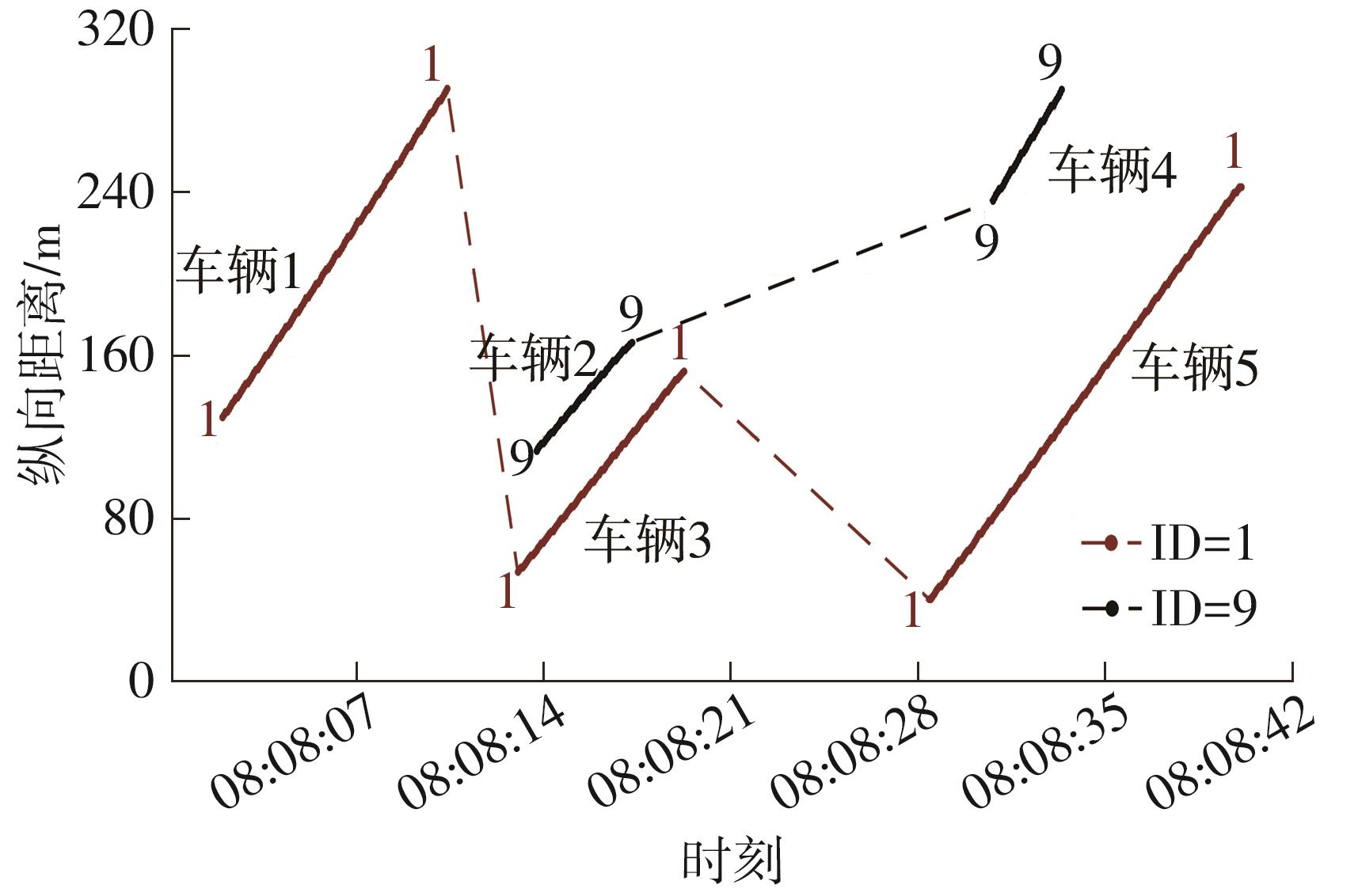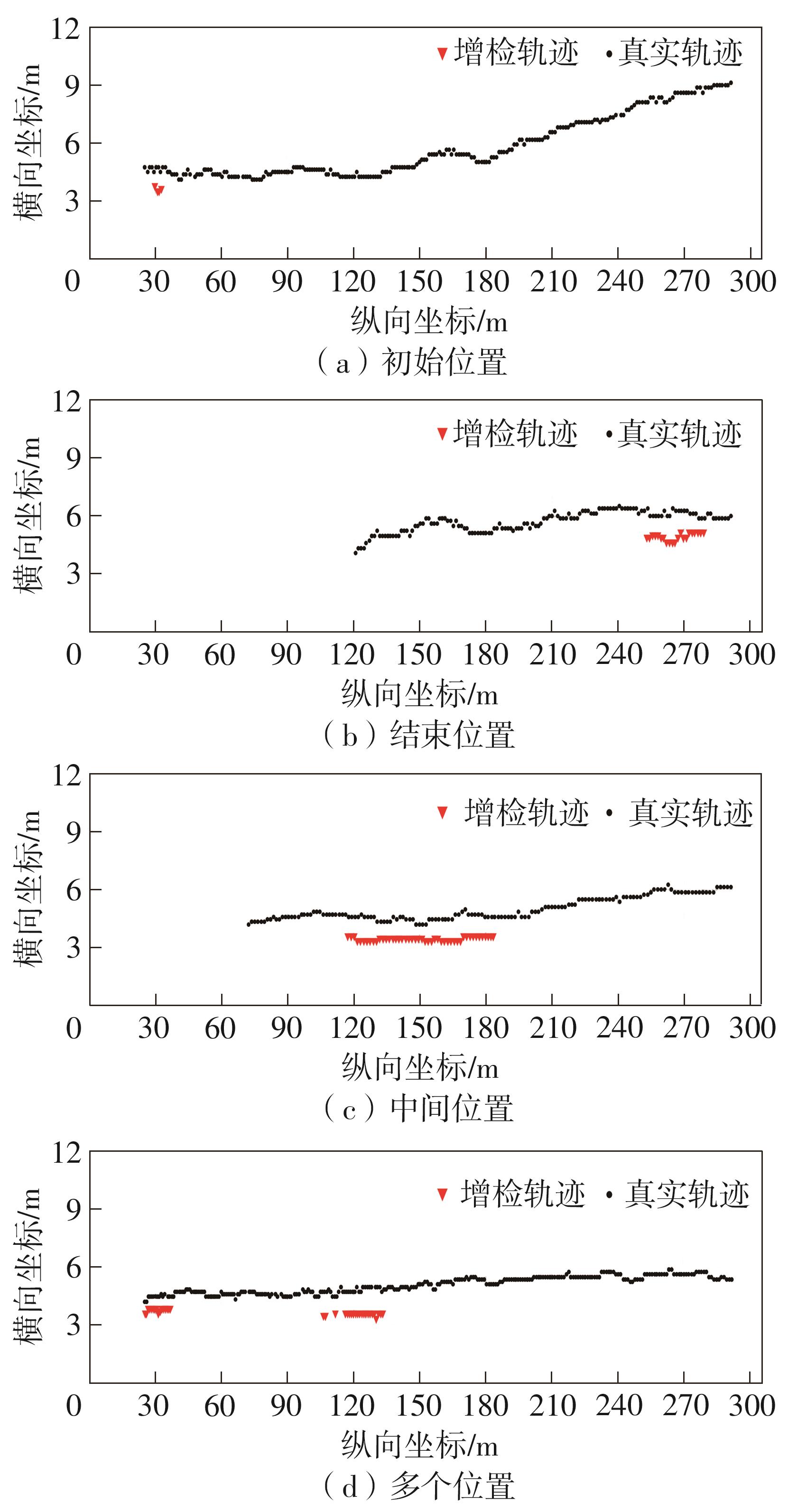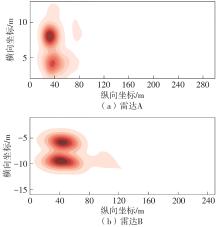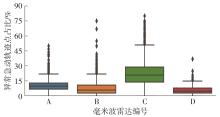Journal of South China University of Technology(Natural Science Edition) ›› 2024, Vol. 52 ›› Issue (6): 56-72.doi: 10.12141/j.issn.1000-565X.230314
Special Issue: 2024年绿色智慧交通
• Green & Intelligent Transportation • Previous Articles Next Articles
Quality Assessment Method of Vehicle Trajectory Data from Roadside Perception
LEI Cailin1( ), ZHAO Cong1, LOU Ren2, JI Yuxiong1(
), ZHAO Cong1, LOU Ren2, JI Yuxiong1( ), DU Yuchuan1
), DU Yuchuan1
- 1.Key Laboratory of Road and Traffic Engineering of the Ministry of Education,Tongji University,Shanghai 201804,China
2.Research and Development Center of Transport Industry of New Generation of Artificial Intelligence Technology,Zhejiang Scientific Research Institute of Transport,Hangzhou 310023,Zhejiang,China
-
Received:2023-05-10Online:2024-06-10Published:2023-10-27 -
Contact:JI Yuxiong E-mail:2010762@tongji.edu.cn;yxji@tongji.edu.cn -
Supported by:the National Key Research and Development Program of China(2022YFF0604900);the National Natural Science Foundation of China(52302415)
CLC Number:
Cite this article
LEI Cailin, ZHAO Cong, LOU Ren, JI Yuxiong, DU Yuchuan. Quality Assessment Method of Vehicle Trajectory Data from Roadside Perception[J]. Journal of South China University of Technology(Natural Science Edition), 2024, 52(6): 56-72.
share this article
Table 7
Factors influencing assessment metrics influence and applications that may be influenced"
| 评价维度 | 评价指标 | 影响因素 | 可能被影响的应用 |
|---|---|---|---|
| 完整性 | 轨迹完整度 | 物理遮挡,设备识别及跟踪目标的能力 | 交通流管控,驾驶行为分析 |
| 一致性 | 流量一致度 | 物理遮挡,设备识别及跟踪目标的能力 | 交通流管控,交通状态识别 |
| 车辆ID一致度 | 物理遮挡,设备识别及跟踪目标的能力 | 驾驶行为分析,车路协同 | |
| 车型一致度 | 物理遮挡,设备识别目标的能力 | 交通流管控,驾驶行为分析 | |
| 准确性 | 纵向定位漂移率 | 设备定位目标的能力 | 驾驶行为分析,车路协同 |
| 回传时间稳定度 | 设备记录数据的时效及稳定性 | 驾驶行为分析,车路协同 | |
| 有效性 | “假倒车”率 | 设备定位目标的能力 | 驾驶行为分析,车路协同 |
| 异常急动率 | 设备检测速度及记录数据的时效、稳定性 | 驾驶行为分析,车路协同 | |
| 交通事故误报率 | 设备定位目标的能力 | 驾驶行为分析,车路协同 |
| 1 | PATRON-PEREZ A, LOVEGROVE S, SIBLEY G .A spline-based trajectory representation for sensor fusion and rolling shutter cameras[J].International Journal of Computer Vision,2015,113(3):208-219. |
| 2 | ZHAO T, XU Y, MONFORT M,et al .Multi-agent tensor fusion for contextual trajectory prediction[C]∥Proceedings of the IEEE/CVF Conference on Computer Vision and Pattern Recognition.[S. l.]:[s. n.],2019:12126-12134. |
| 3 | LEI C, ZHAO C, JI Y,et al .Identifying and correcting the errors of vehicle trajectories from roadside millimetre‐wave radars[J].IET Intelligent Transport Systems,2023,17(2):418-434. |
| 4 | CHEN Z, WU C, HUANG Z,et al .Dangerous driving behavior detection using video-extracted vehicle trajectory histograms[J].Journal of Intelligent Transportation Systems,2017,21(5):409-421. |
| 5 | YU R, HAN L, ZHANG H .Trajectory data based freeway high-risk events prediction and its influencing factors analyses[J].Accident Analysis & Prevention,2021,154:106085/1-10. |
| 6 | 杜豫川,都州扬,师钰鹏,等 .路侧感知车辆轨迹数据质量智能评估方法[J].中国公路学报,2021,34(7):164-176. |
| DU Yu-chuan, DU Zhou-yang, SHI Yu-peng,et al .Intelligent evaluation method for roadside sensing vehicle trajectory data quality[J].Chinese Journal of Highways,2021,34(7):164-176. | |
| 7 | ROCHA T V DA, LECLERCQ L, MONTANINO M,et al .Does traffic-related calibration of car-following models provide accurate estimations of vehicle emissions?[J].Transportation Research Part D:Transport and Environment,2015,34:267-280. |
| 8 | SHARMA A, ZHENG Z, BHASKAR A .A pattern recognition algorithm for assessing trajectory completeness[J].Transportation Research Part C:Emerging Technologies,2018,96:432-457. |
| 9 | KESTING A, TREIBER M .Calibrating car-following models by using trajectory data:methodological study[J].Transportation Research Record,2008,2088(1):148-156. |
| 10 | SADEQ H, SAYED T .Automated roundabout safety analysis:diagnosis and remedy of safety problems[J].Journal of Transportation Engineering,2016,142(12):04016062/1-8. |
| 11 | TAGELDIN A, SAYED T, ISMAIL K .Evaluating the safety and operational impacts of left-turn bay extension at signalized intersections using automated video analysis[J].Accident Analysis & Prevention,2018,120:13-27. |
| 12 | JI Y, NI L, ZHAO C,et al .TriPField: a 3D potential field model and its applications to local path planning of autonomous vehicles[J].IEEE Transactions on Intelligent Transportation Systems,2023,24(3):3541-3554. |
| 13 | ZHAO C, SONG A, ZHU Y,et al .Data-driven indoor positioning correction for infrastructure-enabled autonomous driving systems: a lifelong framework[J].IEEE Transactions on Intelligent Transportation Systems,2023,24(4):3908-3921. |
| 14 | FARAH H, DAAMEN W, HOOGENDOORN S .How do drivers negotiate horizontal ramp curves in system interchanges in the Netherlands?[J].Safety Science,2019,119:58-69. |
| 15 | BEINUM A, FARAH H, WEGMAN F,et al .Driving behaviour at motorway ramps and weaving segments based on empirical trajectory data[J].Transportation Research Part C:Emerging Technologies,2018,92:426-441. |
| 16 | WANG C, XU C, DAI Y .A crash prediction method based on bivariate extreme value theory and video-based vehicle trajectory data[J].Accident Analysis & Prevention,2019,123:365-373. |
| 17 | GU X, ABDEL-ATY M, XIANG Q,et al .Utilizing UAV video data for in-depth analysis of drivers’ crash risk at interchange merging areas[J].Accident Analysis & Prevention,2019,123:159-169. |
| 18 | ZHANG L Y, PENG Z R, SUN D J,et al .A UAV-based automatic traffic incident detection system for low volume roads[R].[S. l.]:[s. n.],2013. |
| 19 | COIFMAN B, MCCORD M, MISHALANI R G,et al .Roadway traffic monitoring from an unmanned aerial vehicle[J].IEE Proceedings - Intelligent Transport Systems,2006,153(1):11-20. |
| 20 | JIN P J, ARDESTANI S M, WANG Y,et al .Unmanned aerial vehicle (UAV) based traffic monitoring and management[R].New Jersey:Center for Advanced Infrastructure and Transportation of Rutgers University,2016. |
| 21 | MA W, HE Z, WANG L,et al .Active traffic management strategies for expressways based on crash risk prediction of moving vehicle groups[J].Accident Analysis & Prevention,2021,163:106421/1-12. |
| 22 | PUNZO V, BORZACCHIELLO M T, CIUFFO B .On the assessment of vehicle trajectory data accuracy and application to the Next Generation SIMulation (NGSIM) program data[J].Transportation Research Part C:Emerging Technologies,2011,19(6):1243-1262. |
| 23 | COIFMAN B, LI L .A critical evaluation of the Next Generation Simulation (NGSIM) vehicle trajectory dataset[J].Transportation Research Part B:Metho-dological,2017,105:362-377. |
| 24 | WANG Z, LU M, YUAN X,et al .Visual traffic jam analysis based on trajectory data[J].IEEE Transactions on Visualization and Computer Graphics,2013,19(12):2159-2168. |
| 25 | ZWAHLEN H T, RUSS A, ONER E,et al .Evaluation of microwave radar trailers for nonintrusive traffic measurements[J].Transportation Research Record,2005,1917(1):127-140. |
| 26 | KIM S, COIFMAN B .Assessing the performance of SpeedInfo radar traffic sensors[J].Journal of Intelligent Transportation Systems,2017,21(3):179-189. |
| 27 | 王宝锋 .基于机器学习与传感器融合的车辆与车道线识别研究[D].北京:北京理工大学,2017. |
| 28 | HU H .Measuring the effectiveness of advanced traveler information systems (ATIS)[D].Raleigh:North Carolina State University,2008. |
| 29 | 杜豫川,师钰鹏,都州扬,等 .智能网联环境下路侧感知单元数据质量在线监测框架[J].中国公路学报,2022,35(3):273-285. |
| DU Yu-chuan, SHI Yu-peng, DU Zhou-yang,et al .A framework for online monitoring of data quality of roadside sensing units in an intelligent networked environment[J].Chinese Journal of Highways,2022,35(3):273-285. | |
| 30 | 林宇 .基于 GNSS 的异常定位序列挖掘方法研究[D].长春:吉林大学,2020. |
| 31 | LI Z, LI X, LIU S,et al .A study on trajectory planning of hydraulic robotic excavator based on movement stability[C]∥Proceedings of 2016 13th International Conference on Ubiquitous Robots and Ambient Intelligence (URAI).[S. l.]:IEEE,2016:582-586. |
| 32 | YANG C, GIDÓFALVI G .Trajectory quality assessment based on movement feature stability[C]∥Proceedings of the International Symposium on Location-Based Big Data.Tokyo:[s. n.],2019. |
| 33 | 王风伟 .车辆轨迹数据质量评价方法研究[D].哈尔滨:哈尔滨工业大学,2017. |
| 34 | MEINEL H H .Applications of microwaves and millimeter waves for vehicle communications and control in Europe[C]∥Proceedcings of 1992 IEEE MTT-S Microwave Symposium Digest.[S.l.]:IEEE,1992:609-612. |
| 35 | 施莉娟,朱健,陈小鸿,等 .基础交通数据质量评价研究[J].交通信息与安全,2011,29(5):57-61. |
| SHI Lijuan, ZHU Jian, CHEN Xiaohong,et al .Study on the quality evaluation of basic traffic data[J].Traffic Information and Safety,2011,29(5):57-61. | |
| 36 | LIU P, YU G, WANG Z,et al .Object classification based on enhanced evidence theory:radar-vision fusion approach for roadside application[J].IEEE Transactions on Instrumentation and Measurement,2022,71:1-12. |
| 37 | DU L P, SU G C .new method for target detection of MMW radar[C]∥Proceedings of the 7th International Conference on Signal Processing,2004.[S. l.]:IEEE,2004:2029-2032. |
| 38 | DIAKOULAKI D, MAVROTAS G, PAPAYANNAKIS L .Determining objective weights in multiple criteria problems:the critic method[J].Computers & Operations Research,1995,22(7):763-770. |
| 39 | CAI X, LEI C, PENG B,et al .Road traffic safety risk estimation method based on vehicle onboard diagnostic data[J].Journal of Advanced Transportation,2020,2020:1-13. |
| 40 | ZHAO C, SONG A, DU Y,et al .TrajGAT:a map-embedded graph attention network for real-time vehicle trajectory imputation of roadside perception[J].Transportation Research Part C:Emerging Technologies,2022,142:103787/1-23. |
| 41 | DU Y, QIN B, ZHAO C,et al .A novel spatio-temporal synchronization method of roadside asynchronous MMW radar-camera for sensor fusion[J].IEEE transactions on Intelligent Transportation Systems,2021,23(11):22278-22289. |
| [1] |
ZHONG Shaopeng, LIU Ao, ZHAI Junnuo, et al.
A Review of The Multi-Level Urban Impacts of Shared Autonomous Vehicles [J]. Journal of South China University of Technology(Natural Science Edition), 2025, 53(6): 104-118. |
| [2] | ZHANG Yunchao, HUANG Jianling, LI Yongxing, et al. Online Driving Style Recognition Method Considering Lane-Changing Game [J]. Journal of South China University of Technology(Natural Science Edition), 2024, 52(4): 126-137. |
| [3] | . Effect of Combination Mode of Traffic Guidance Information on Route Decision-Making [J]. Journal of South China University of Technology (Natural Science Edition), 2017, 45(8): 77-83. |
| [4] | WANG Ze-sheng DONG Bao-tian WANG Ai-li. Pedestrian Detection Method Based on Adaptive Pulse-Coupled Neural Networks [J]. Journal of South China University of Technology (Natural Science Edition), 2017, 45(6): 74-80. |
| [5] | Qin Hua-biao Xiao Zhi-yong . A Position-Based Stable Clustering Routing Protocol [J]. Journal of South China University of Technology (Natural Science Edition), 2010, 38(6): 1-6. |
| [6] | Wen Hui-ying Xu Jian-min Zou Liang. Genetic Algorithm-Based Computation of the Shortest Path in Discrete-Time Dynamic Networks [J]. Journal of South China University of Technology (Natural Science Edition), 2008, 36(2): 13-16,28. |
| [7] | Huang Ling Xu Jian-min. Dynamic Traffic Congestion Prediction Model Based on Probe Vehicle Technology [J]. Journal of South China University of Technology (Natural Science Edition), 2008, 36(10): 47-50,56. |
| [8] | Shi Sheng-li Xu Jian-min Qin Zhong. Vehicle Positioning ßased on CDMA and GSM Networks [J]. Journal of South China University of Technology (Natural Science Edition), 2007, 35(2): 50-53. |
| [9] | Zhong Hui-ling Xu Jian-min Peng Xuan-rong. Solution to and Analysis of the Model of Dedicated Short-Range Communication Protocol [J]. Journal of South China University of Technology (Natural Science Edition), 2005, 33(6): 18-22. |
| [10] | Zhong Hui-ling Xu Jian-min Peng Xuan-rong. Establishment of Dedicated Short-Range Comm unication Protocol Model [J]. Journal of South China University of Technology (Natural Science Edition), 2005, 33(4): 34-38. |
| [11] | Chen Wei Ding Qiu-lin Xie Qiang. Interactive Data Migration System and Its Approximately-detecting Efficiency Optimization [J]. Journal of South China University of Technology(Natural Science Edition), 2004, 32(2): 58-61. |
| [12] | Hu Yu-cong, Xu Jian-min, Wu Yi-min, et al. Fusion Model of Vehicle Positioning Based on BP Neural Network [J]. Journal of South China University of Technology(Natural Science Edition), 2004, 32(2): 46-49. |
| Viewed | ||||||
|
Full text |
|
|||||
|
Abstract |
|
|||||

































